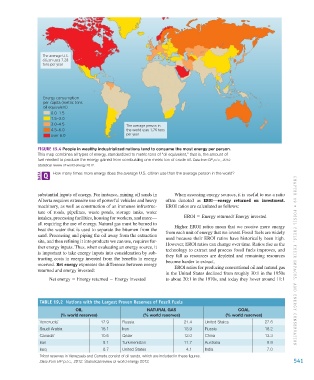Page 542 - Environment: The Science Behind the Stories
P. 542
The average U.S.
citizen uses 7.28
tons per year
Energy consumption
per capita (metric tons
oil equivalent)
0.0–1.5
1.5–3.0
3.0–4.5 The average person in
4.5–6.0 the world uses 1.76 tons
over 6.0 per year
FIGURE 19.4 People in wealthy industrialized nations tend to consume the most energy per person.
This map combines all types of energy, standardized to metric tons of “oil equivalent,” that is, the amount of
fuel needed to produce the energy gained from combusting one metric ton of crude oil. Data from BP p.l.c., 2012.
Statistical review of world energy 2012.
How many times more energy does the average U.S. citizen use than the average person in the world?
substantial inputs of energy. For instance, mining oil sands in When assessing energy sources, it is useful to use a ratio
Alberta requires extensive use of powerful vehicles and heavy often denoted as EROI—energy returned on investment.
machinery, as well as construction of an immense infrastruc- EROI ratios are calculated as follows:
ture of roads, pipelines, waste ponds, storage tanks, water
intakes, processing facilities, housing for workers, and more— EROI 5 Energy returned/ Energy invested
all requiring the use of energy. Natural gas must be burned to Higher EROI ratios mean that we receive more energy
heat the water that is used to separate the bitumen from the from each unit of energy that we invest. Fossil fuels are widely
sand. Processing and piping the oil away from the extraction used because their EROI ratios have historically been high.
site, and then refining it into products we can use, requires fur- However, EROI ratios can change over time. Ratios rise as the
ther energy inputs. Thus, when evaluating an energy source, it technology to extract and process fossil fuels improves, and
is important to take energy inputs into consideration by sub- they fall as resources are depleted and remaining resources
tracting costs in energy invested from the benefits in energy become harder to extract. CHAPTER 19 • FOSSIL FUELS, THEIR IMPA CT S, AND ENERGY CONSERVATI ON
received. Net energy expresses the difference between energy EROI ratios for producing conventional oil and natural gas
returned and energy invested:
in the United States declined from roughly 30:1 in the 1950s
Net energy 5 Energy returned 2 Energy invested to about 20:1 in the 1970s, and today they hover around 11:1
TABLE 19.2 Nations with the Largest Proven Reserves of Fossil Fuels
OIL NATURAL GAS COAL
(% world reserves) (% world reserves) (% world reserves)
Venezuela * 17.9 Russia 21.4 United States 27.6
Saudi Arabia 16.1 Iran 15.9 Russia 18.2
Canada * 10.6 Qatar 12.0 China 13.3
Iran 9.1 Turkmenistan 11.7 Australia 8.9
Iraq 8.7 United States 4.1 India 7.0
* Most reserves in Venezuela and Canada consist of oil sands, which are included in these figures.
Data from BP p.l.c., 2012. Statistical review of world energy 2012. 541
M19_WITH7428_05_SE_C19.indd 541 12/12/14 5:22 PM

